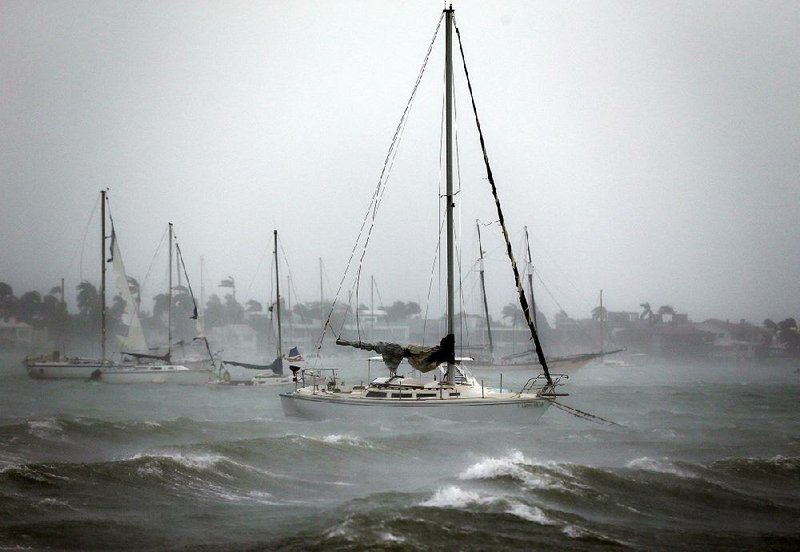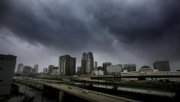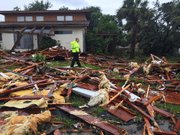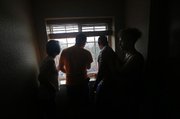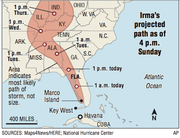MIAMI -- Hurricane Irma gave Florida a coast-to-coast pummeling with winds up to 130 mph Sunday, swamping homes and boats, knocking out power to millions and toppling construction cranes over the Miami skyline.
The 400-mile-wide storm blew ashore in the morning in the mostly cleared-out Florida Keys, then began a slow march up the state's west coast, its winds extending clear across to Miami on the Atlantic side.
Forecasters said it could hit the heavily populated Tampa-St. Petersburg area early today.
"Pray, pray for everybody in Florida," Gov. Rick Scott said on Fox News Sunday as more than 160,000 people statewide waited it out in shelters.
Click here for larger versions
Photos by The Associated Press
Photos by The Associated Press
Scott on Sunday asked for a major disaster declaration from President Donald Trump "to help bring important federal resources and aid to Florida" once Irma passes, he said.
Irma arrived as a Category 4 storm but by late afternoon had weakened to a Category 2 with 105 mph winds. A storm surge of 10 feet was recorded in the Keys, and forecasters warned some places on the mainland could get up to 15 feet of water.
Trump said Sunday that "we may have been a little bit lucky" after Hurricane Irma veered from its original course and headed along Florida's west coast, instead of east. He said that path might be less destructive.
There were no immediate confirmed reports of any deaths in Florida, on top of the 24 people killed during Irma's destructive trek across the Caribbean.
[HURRICANE TRACKER: Follow Irma’s projected path]
Bryan Koon, Florida's emergency management director, said late Sunday that authorities had only scattered information about the storm's toll, but he remained hopeful.
"I've not heard of catastrophic damage. It doesn't mean it doesn't exist. It means it hasn't gotten to us yet," Koon said.
In the low-lying Keys, appliances and furniture were seen floating away, and Monroe County spokesman Cammy Clark said the ocean waters were filled with navigation hazards, including sunken boats and loose vessels. But the full extent of Irma's wrath there was not clear.
The county administrator, Roman Gastesi, said crews would begin house-to-house searches today to check on survivors. And an airborne relief mission, led by C-130 military cargo planes, was gearing up to take emergency supplies to the Keys.
A Miami woman who went into labor was guided through delivery by phone when authorities couldn't reach her in high winds and street flooding. Firefighters later took her to a hospital.
An apparent tornado spun off by Irma destroyed six mobile homes in Palm Bay, midway up the Atlantic coast. Flooding was reported along Interstate 4, which cuts across Florida's midsection.
In downtown Miami, two of the two dozen construction cranes looming over the skyline collapsed in the wind. A third crane was reported down in Fort Lauderdale. No injuries were reported.
In Estero, on the west coast of Florida, thousands of people wrapped around the Germain Arena, which officials opened as a shelter Saturday and has a capacity of 7,000 to 8,000. At least six ambulances responded to people who were overcome in the muggy, 90-degree heat. Troopers, the National Guard and local police sought out people in wheelchairs and moved them to the front of the line, said Lt. Greg Bueno, public information officer for the Florida Highway Patrol.
Dianne and Riley Abshire, who moved to Florida six years ago from Ottawa, Ohio, were going through their first hurricane in an Estero house they trusted would stand up to Irma.
"I feel like I'm in a sardine can, and I don't like it," Dianne said.
Curfews were imposed in Miami, Tampa, Fort Lauderdale and much of the rest of South Florida, and some arrests of violators were reported. Miami Beach barred outsiders from the island.
Fort Lauderdale police arrested nine people they said were caught on TV cameras looting sneakers and other items from a sporting goods store and a pawn shop during the hurricane.
Despite tornado warnings and curfews, some decided to venture back into the storm. At Pompano Beach High School, which has been transformed into a shelter, several people decided to leave Saturday night once it looked like the storm's core was shifting away from the eastern part of the state.
"We've got hurricane windows at home and the forecast looks like it's not going to be as bad as they predicted," said Laurie Trinkle, who arrived with relatives shortly after noon on Saturday and decided to leave about 12 hours later. "I think we'll be more comfortable at home as long as the power stays on."
3.3 MILLION WITHOUT LIGHTS
At least 3.3 million homes and businesses across the state lost power, and utility officials said it will take weeks to restore electricity to everyone.
While Irma raked the state's Gulf Coast, forecasters warned that the entire state -- including the Miami metropolitan area of 6 million people -- was in danger because of the sheer size of the storm.
Nearly 7 million people in the Southeast were warned to evacuate, including 6.4 million in Florida alone.
About 30,000 people heeded orders to leave the Keys as the storm closed in, but an untold number refused, in part because to many storm-hardened residents, staying behind in the face of danger is a point of pride.
John Huston, who stayed in his Key Largo home, watched his yard flood even before the arrival of high tide.
"Small boats floating down the street next to furniture and refrigerators. Very noisy," he said by text message. "Shingles are coming off."
Concerns stretched up the coast, into nearby states where some evacuees sought shelter. About 540,000 people in Georgia and 44,000 in South Carolina also were ordered to evacuate the area by Sunday evening. Airports throughout Florida and in Savannah, Ga., were closed. Disney World is closed Sunday and today, with resort hotels staying open.
Florida authorities said that by Sunday afternoon there were more than 530 shelters open with more than 160,000 people inside.
Irma made landfall just after 9 a.m. at Cudjoe Key, about 20 miles outside Key West. Irma left the Keys by midday Sunday and headed toward the southwest coast of Florida, the National Weather Service reported.
After churning through the Keys and on through to Florida's southwestern coast, Irma's second landfall occurred in Marco Island, Fla., at 3:35 p.m. A wind gust of 130 mph was reported by the Marco Island police, according to the National Weather Service.
Forecasters said Sunday that water levels in the Naples and Marco Island region could "rapidly rise in a matter of minutes," which could create life-threatening storm surge in this area. Marco Island officials on Sunday afternoon urged people to leave the ground floors of places and head to the "second or higher floor if possible."
During the afternoon, Irma rounded Florida's southwestern corner and hugged the coast closely as it pushed toward Naples, Sanibel, Fort Myers and, beyond that, Sarasota, at 14 mph.
Meteorologist Ryan Maue of WeatherBell Analytics said the entire Florida Peninsula will be raked by Irma's right front quadrant -- the part of a hurricane that usually brings the strongest winds, storm surge, rain and tornadoes.
Gretchen Blee, who moved with her husband to Naples from Long Island, N.Y., after superstorm Sandy in 2012 heavily damaged their beach home, took cover in a hotel room as Irma raged.
"I said let's go and live the good life in paradise," she said. "And here we are."
"Today is going to be the long day," said Mark DeMaria, deputy acting director of the National Hurricane Center in Miami.
The hurricane center warned that Irma had created an "imminent danger of life-threatening storm surge flooding along much of the Florida west coast" and said the storm was expected to "move near or over the west coast of the Florida Peninsula through this morning."
Some 400 miles north of the Keys, people in the Tampa-St. Petersburg area started bracing for the onslaught. The Tampa Bay area, with a population of about 3 million, has not taken a direct hit from a major hurricane since 1921.
Tampa is especially prone to flooding because it is low lying with a big bay, and inlets that face the shallow, warm waters of the Gulf of Mexico.
By Sunday morning, the storm surge forecast grew more menacing.
"If you're in an evacuation zone, you do not want to be there when the surge comes," NHC specialist Mike Brennan warned Gulf Coast residents. "You can lose your life. It's as simple as that."
The Tampa-St. Petersburg metro area -- Florida's second largest -- has been rated as the nation's most vulnerable region to a major storm surge with estimated property losses of $175 billion in the event of a 100-year hurricane, according to a Boston company that specializes in assessing the risk of catastrophes.
"A severe storm with the right-track orientation will cause an enormous buildup of water that will become trapped in the bay and inundate large areas of Tampa and St. Petersburg," with 50 percent of their population living on ground elevations less than 10 feet, according to a 2015 report by Karen Clark & Company.
"I've been here with other storms, other hurricanes. But this one scares me," Sally Carlson said as she snapped photos of the waves crashing against boats in St. Petersburg. "Let's just say a prayer we hope we make it through."
ATLANTA IN CROSS HAIRS
After leaving Florida, a weakened Irma is expected to push into Georgia, Alabama, Mississippi, Tennessee and beyond. A tropical storm warning was issued for the first time ever in Atlanta, some 200 miles from the sea.
President Donald Trump approved a disaster declaration for Florida, opening the way for federal aid.
"Once this system passes through, it's going to be a race to save lives and sustain lives," Federal Emergency Management Agency chief Brock Long said on Fox News Sunday.
The White House said Trump had received a "comprehensive update" on Irma earlier Sunday while at Camp David that included details on her status, path forecast, evacuations and preparations for response and recovery. He thanked FEMA and the Homeland Security Department, which oversees the agency, for their efforts, and encouraged officials to also stay focused on the post-Harvey recovery.
Vice President Mike Pence and several Cabinet secretaries who were at Camp David for Trump's storm briefing later visited FEMA headquarters.
"The people of Florida need to know that our hearts and our prayers and all of our efforts are with them and will be with them until this storm passes," the vice president said.
Trump spoke with the governors of Alabama, Georgia, South Carolina and Tennessee. Forecasters warned that after churning up Florida's west coast, a weakened Irma could push into those states. The National Weather Service on Sunday issued a first-ever tropical storm warning for Atlanta.
Florida's governor activated all 7,000 members of the Florida National Guard, and 10,000 guardsmen from elsewhere were being deployed.
Meanwhile, Scott acknowledged that the fuel shortage that Irma had caused is likely to continue, despite the state's efforts to ensure extra supplies.
Ports in Tampa and Miami -- which, Scott said, are the primary ways fuel is transported to the state -- were closed because of the storm. "As soon as the storm passes, we will work to open those ports and get fuel here," he said.
Irma at one time was the most powerful hurricane ever recorded in the open Atlantic, a Category 5 with a peak wind speed of 185 mph, and its approach set off alarm in Florida.
For days, forecasters had warned that Irma was taking dead aim at the Miami area and the rest of the state's Atlantic coast.
But then Irma made a more pronounced westward shift that put a bull's-eye on the Tampa area -- the result of what meteorologists said was an atmospheric tug-of-war between weather systems that nudged Irma and determined when it made its crucial right turn into Florida.
Information for this article was contributed by Jennifer Kay, Freida Frisaro, Seth Borenstein, Tamara Lush, Terry Spencer, Gary Fineout, Terrance Harris, Claire Galofaro, Jason Dearen, Darlene Superville and David Fischer of The Associated Press; Jay Weaver, Charles Rabin, Kristen M. Clark and Chloe Herring of Tribune News Service; and Perry Stein, Mark Berman, Wesley Lowery, Joel Achenbach, Patricia Sullivan, Scott Unger, Leonard Shapiro, Lori Rozsa, Rachelle Krygier, Sarah Larimer, Lori Aratani, Thomas M. Gibbons-Neff, Steven Mufson, Jason Samenow and Angela Fritz of The Washington Post.
A Section on 09/11/2017
